driver seat adjustment AUDI A6 2018 Owners Manual
[x] Cancel search | Manufacturer: AUDI, Model Year: 2018, Model line: A6, Model: AUDI A6 2018Pages: 266, PDF Size: 41.38 MB
Page 25 of 266
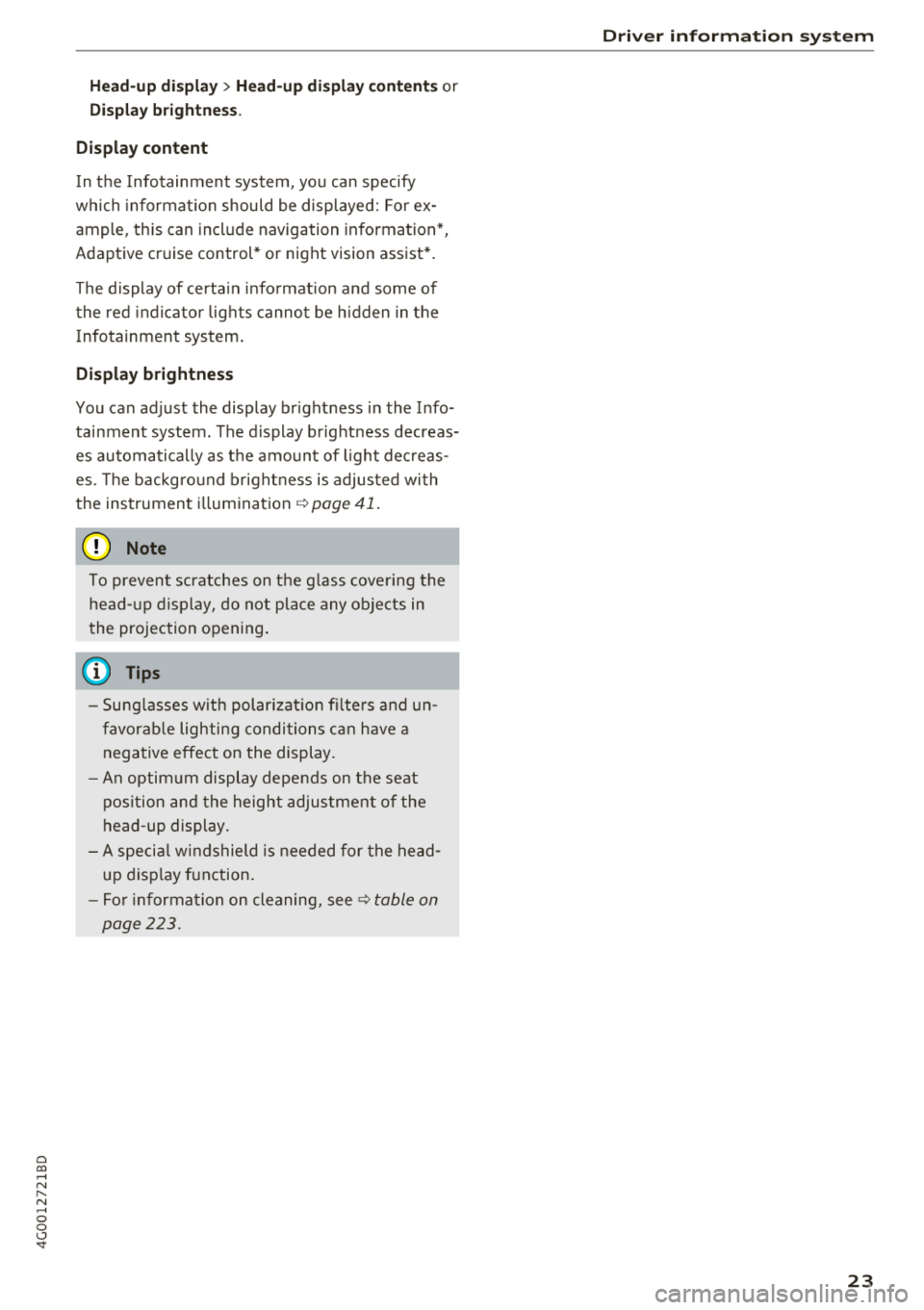
a co .... N
" N .... 0 0 \,;J '
Display brightness.
Display content
In the Infotainment system, you can specify
which information should be displayed: For ex
ample , this can include navigation information*,
Adaptive cruise control* or night vision assist*.
The display of certain information and some of
the red indicator lights cannot be hidden in the
Infotainment system.
Display brightness
You can adjust the display brightness in the Info
tainment system. The display brightness decreas
es automatically as the amount of light decreas
es. The background brightness is adjusted with
the instrument illumination
q pag e 41.
@ Note
To prevent scratches on the glass covering the
head-up display, do not place any objects in
the projection opening.
(j) Tips
-Sunglasses with polarization filters and un
favorable lighting conditions can have a negative effect on the display.
- An optimum display depends on the seat
position and the height adjustment of the
head-up display.
- A special windshield is needed for the head
up display function.
- For information on cleaning, see
q table on
page 223 . Driver information
system
23
Page 50 of 266
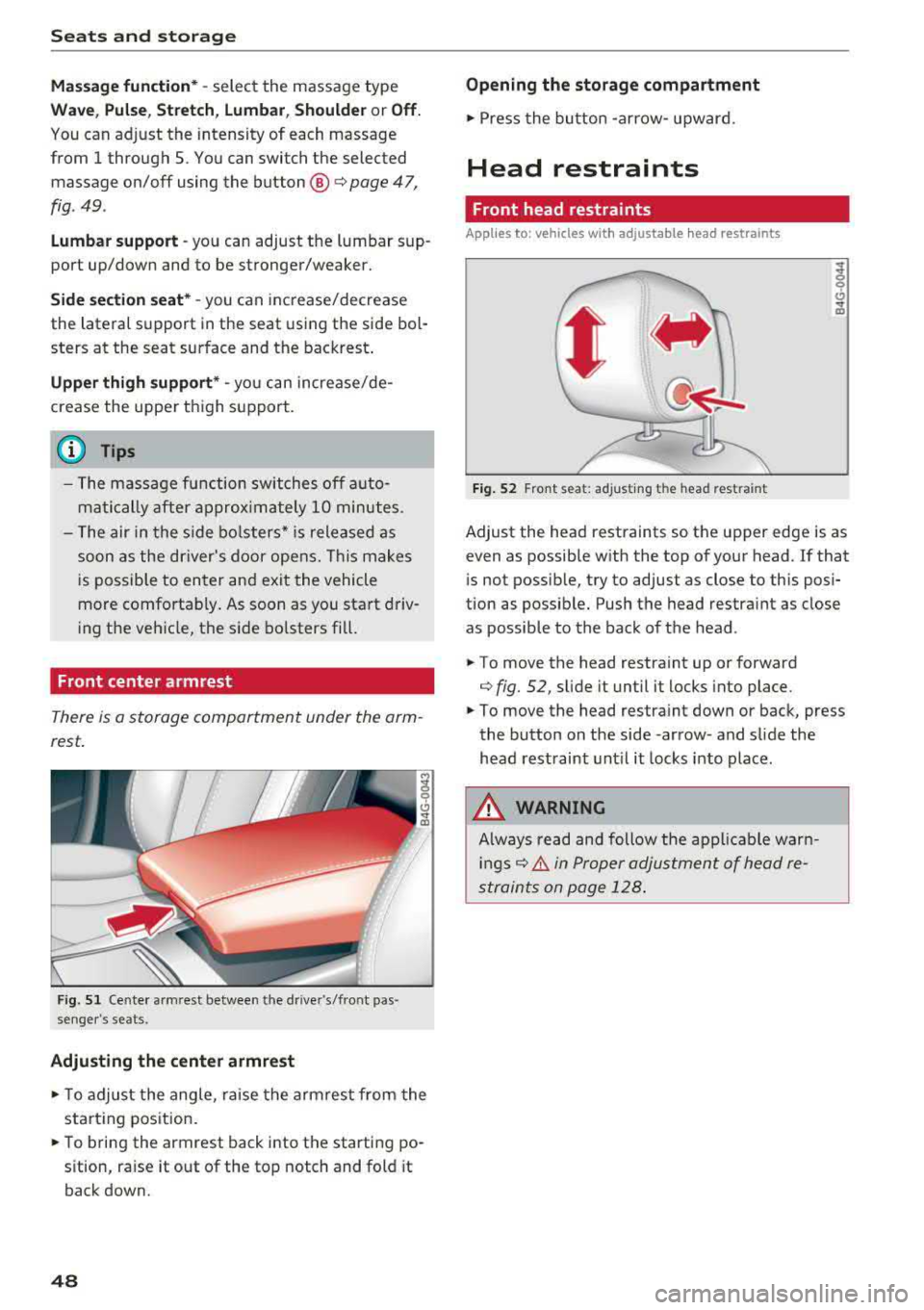
Seats and storage
Massage function*
-select the massage type
Wave , Pulse , Stretch , Lumbar , Shoulder or Off.
You can adjust the intensity of each massage
from 1 through 5 . You can switch the selected
massage on/off using the
button @¢ page 47,
fig .
49 .
Lumbar support -you can adjust the lumbar sup
port up/down and to be stronger/weaker.
Side section seat* -you can increase/decrease
the lateral support in the seat using the side bol
sters at the seat surface and the backrest.
Upper thigh support* -you can increase/de
crease the upper thigh support.
(D Tips
- The massage function switches off auto
matically after approximately 10 minutes.
- The air in the side bolsters* is released as
soon as the driver's door opens. This makes
is possible to enter and exit the vehicle
more comfortab ly . As soon as you start driv
ing the veh icle, the s ide bolsters fill.
Front center armrest
There is a storage compartment under the arm
rest.
F ig. 51 Cente r armrest between the driver's/front pas ·
senger 's seats.
Adjusting the center armrest
.,. T o adjust the angle, raise the arm rest from the
starting position .
.,. To bring the armrest back into the starting po
sition, raise it out of the top notch and fold it
back down.
48
Opening the storage compartment
.,. Press the button -arrow- upward.
Head restraints
Front head restraints
Applies to: vehicles with adjustable head restra ints
Fig. 52 Front seat: ad justing t he head rest ra in t
Adjust the head restraints so the upper edge is as
even as possible with the top of your head. If that
is not possib le, try to adjust as close to this posi
tion as possib le. Push the head restraint as close
as possible to the back of the head.
.,. To move the head restra int up or forward
¢ fig. 52, sli de it until it locks into place .
.,. To move the head restra int down or back, press
the button on the side -arrow- and slide the
head restraint until it locks into place.
A WARNING
Always read and follow the applicable warn
ings¢ & in Proper adjustment of head re
straints on page 128.
.
Page 51 of 266
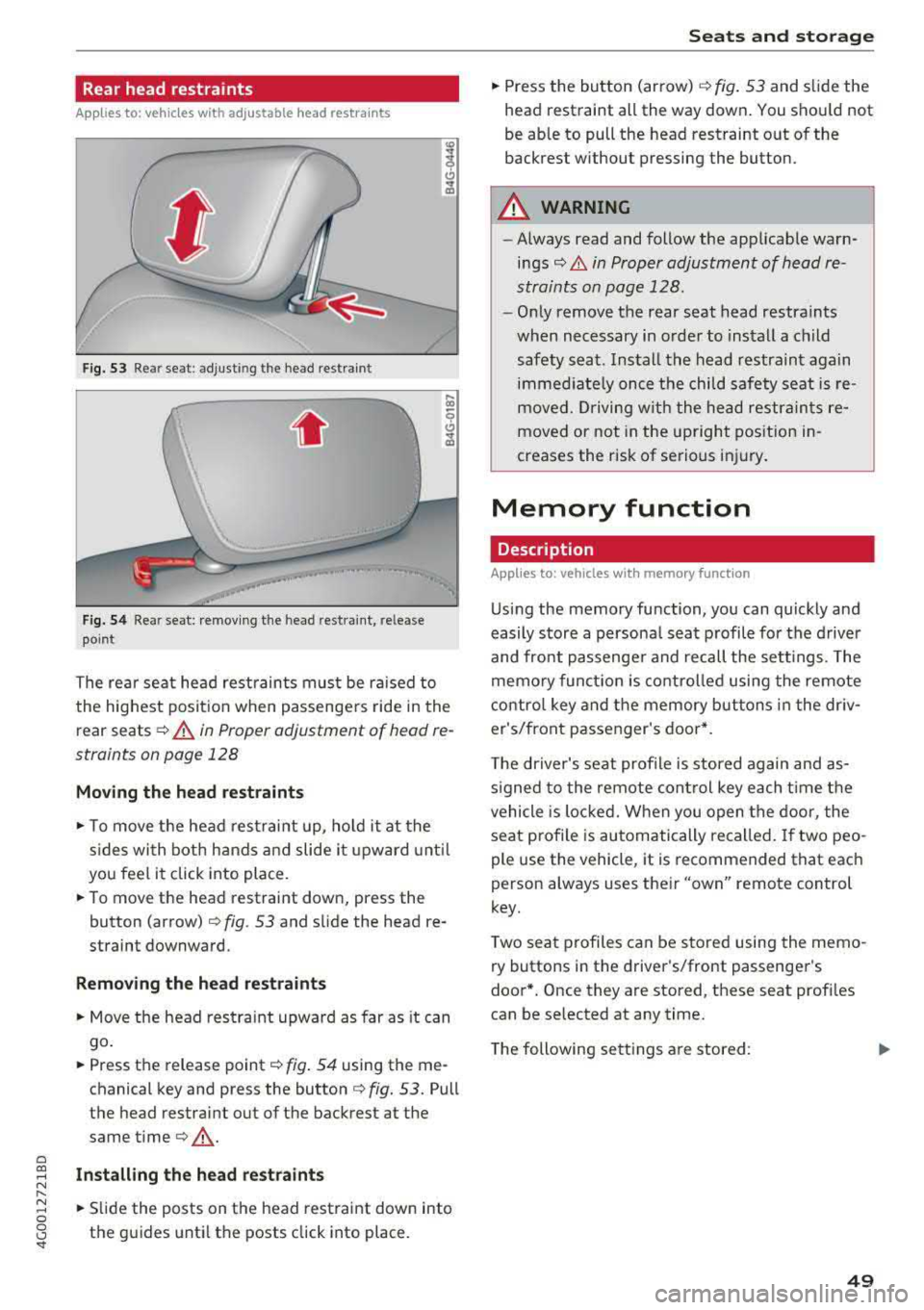
a
Rear head restraints
Applies to: ve hicles with a djustable head restra ints
F ig. 53 Rea r seat: adjusti ng the head restraint
Fig. 54 Rear seat: remov ing the head restra int, release
point
The rear seat head restrain ts must be ra ised to
the highest posit ion when passengers ride in the
rear seats
c::> A in Proper adjustment of head re
straints on page 128
Moving the head rest raints
.,. To move the head rest raint up, ho ld it at the
s ides with both hands a nd slide i t upward unt il
you feel it click into place.
.. To move the head restraint down, press the
button (arrow)
c::> fig. 53 and s lide the head re
straint downward.
Remov ing th e head re straints
.,. Move the head restra int upward as far as it can
go .
.. Press the release point c::> fig . 54 using the me
chanical key and press the button
c::> fig. 53. Pull
the head restraint out of the backrest at the
same
time¢ .,&..
~ Install ing the head re st raint s N
" ~ .. Slide the posts on the head restraint down into 0
8 the guides until the posts click into place. '
.,. Press the button (arrow) ¢ fig. 53 and slide the
head restraint all the way down . You shou ld not
be able to pull the head restraint out of the
backrest without pressing the button.
A WARNING
-==
- Always read and follow the applicable warn-
ings
c::> & in Proper adjustment of head re
straints on page 128.
- Only remove the rear seat head restraints
when necessary in order to install a child
safety seat. Install the head restraint again immed iate ly once the child safety seat is re
moved. Driving w ith the head restraints re
moved or not in the upright position in
creases the risk of serious inj ury.
Memory function
Description
Appl ies to: vehicles wit h memo ry funct ion
Us ing the memory function, you can quickly and
easily store a persona l seat profile fo r the driver
and front passenge r and recall the sett ings. The
memo ry func tion is co ntro lled using the remote
contro l key and the memory buttons i n the dr iv
er's/front passe nger's door*.
T he driver's seat profile is stored again and as
s igned to the remote cont rol key each t ime t he
vehicle is loc ked. When you open the door, the
seat profile is automatically recalled. If two peo
ple use the vehicle, it is recommended that each
person always uses their
"own" remote control
key.
T wo sea t profiles can be stored using the memo
ry buttons in the driver's/front passenger's
door* . Once they are stored, these seat profi les
can be selected at any time .
T he following se tt ings are stored:
..,.
49
Page 52 of 266
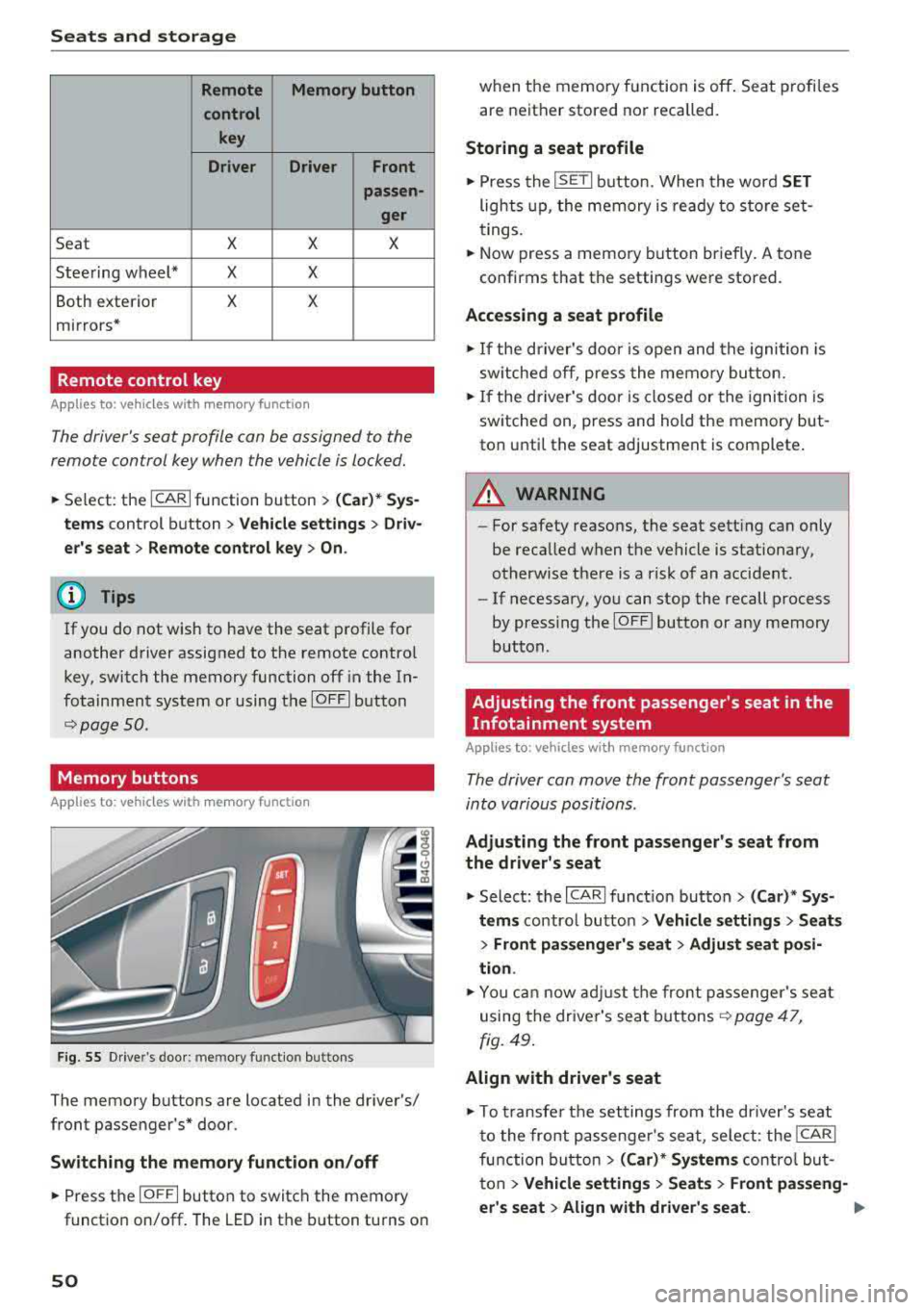
Seats and storage
Remote Memory button
control key
Driver Driver
Front
passen-
ger
Seat X X X
Steering wheel* X X
Both exterior X X
mirrors*
Remote control key
Applies to: vehicles with memory function
The driver 's seat profile can be assigned to the
remo te control key when the vehicle is locked.
.,.. Se lect : the ICARI function button > (Car)* Sys
tems
control button > Vehicle settings > Driv
er 's seat
> Remote control key > On.
(D Tips
If you do not wish to have the seat profile for
another driver assigned to the remote contro l
key, switch the memory function off in the In
fotainment system or using the
IOFFI button
r::::;, page 50 .
Memory buttons
App lies to: vehicles with memory function
F ig. 55 Drive r's door : m em ory functio n bu ttons
The memory buttons are located in the driver's/
front passenger 's* door.
Switching the memory function on/off
.,.. Press the IO FF I button to switch the memory
functio n on/off. The LED in the button turns on
50
when the memory function is off . Seat profiles
are neither stored nor recalled.
Storing a seat profile
.,.. Press the ISET I button . When the word SET
lights up, the memory is ready to store set
tings.
.,.. Now press a memo ry button briefly. A tone
confirms that th e settings were stor ed.
Accessing a seat profile
.,.. If the driver's door is open and the ignition is
sw itched off, press the memory button.
.,.. If the driver's door is closed or the ignition is
switched on, press and hold the memory but
ton until the seat adjustment is complete .
A WARNING
-For safety reasons, the seat setting can only
be recalled when the vehicle is stationary,
otherwise there is a risk of an accident .
-If necessary, you can stop the recall process
by press ing the
IOF FI butto n or any memory
button .
Adjusting the front passenger's seat in the
Infotainment system
Applies to: vehicles with memory function
The driver can move the front passenger's seat
into various positions .
Adjusting the front passenger's seat from
the driver's seat
.,. Select: the I CARI function button > (Car)* Sys
tems
control butto n > Vehicle settings > Seats
> Front passenger's seat > Adjust seat posi
tion .
.,.. You can now adjust the front passenger's seat
using the driver's seat buttons
r:::;, page 47,
fig. 49.
Align with driver's seat
.,. To trans fer the settings from the dr iver's seat
to the front passenge r's seat, select: the
I CAR I
function button > (Car)* Systems control but
ton
> Vehicle settings > Seats > Front passeng-
er 's seat
> Align with driver 's seat. .,..
Page 68 of 266
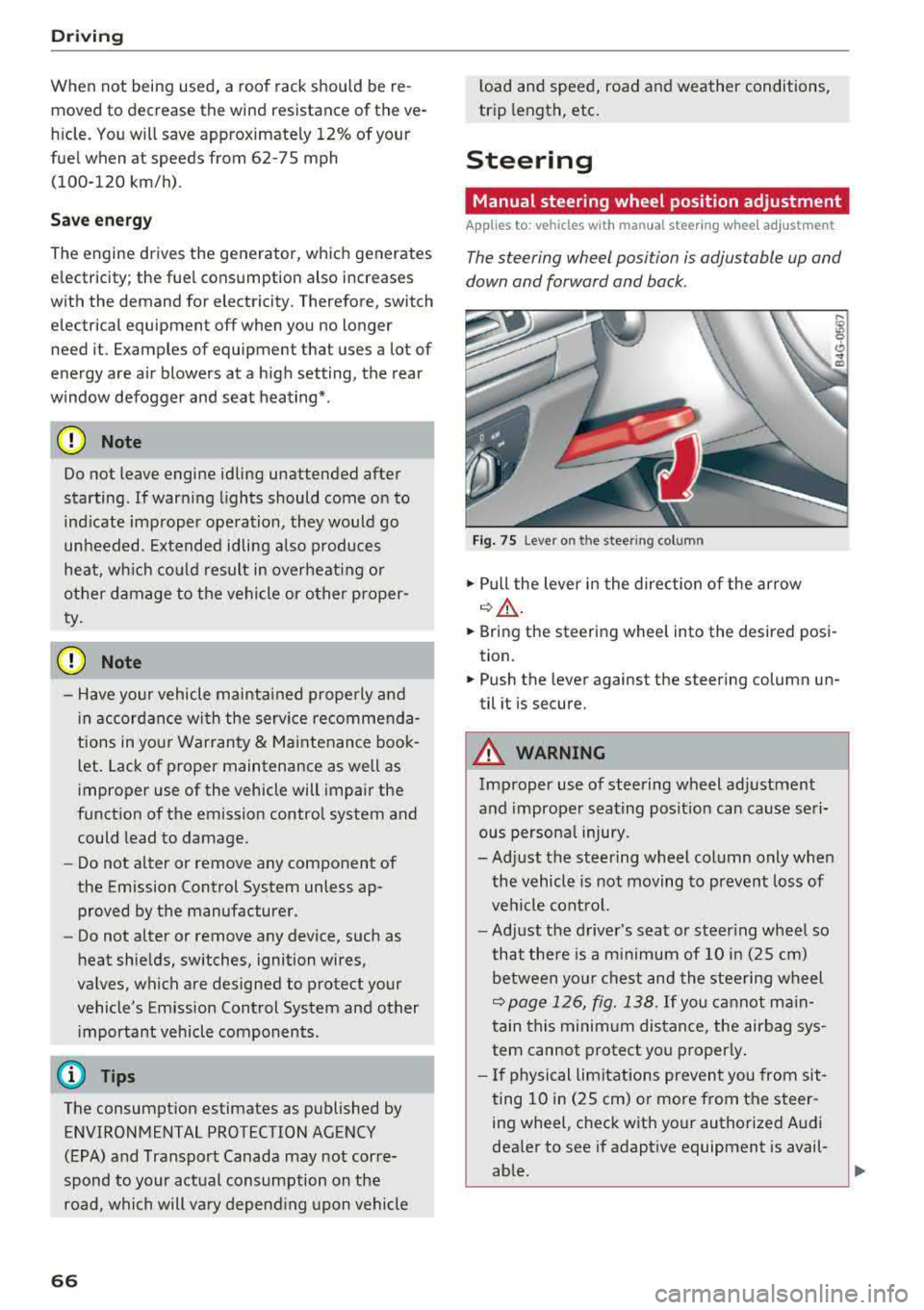
Driving
When not being used, a roof rack should be removed to decrease the wind resistance of the ve
hicle. You will save approximately 12% of your
fuel when at speeds from 62- 7 5 mph
(100-120 km/h) .
Save energy
The engine drives the generator, which generates
electricity ; the fuel consumption also increases
with the demand for electricity. Therefore, switch electrical equipment off when you no longer
need it. Examples of equipment that uses a lot of
energy are air blowers at a high setting, the rear
window defogger and seat heating* .
@ Note
Do not leave engine idling unattended after
starting. If warning lights should come on to
ind icate improper operation, they would go
unheeded. Extended idling also produces
heat, which could result in overheating or
other damage to the vehicle or other proper-
ty.
@ Note
- Have your vehicle maintained properly and
in accordance with the service recommenda
tions in your Warranty
& Maintenance book
let. Lack of proper maintenance as well as
improper use of the vehicle will impair the
function of the emission control system and
could lead to damage.
- Do not alter or remove any component of
the Emission Control System unless ap proved by the manufacturer .
- Do not alter or remove any device , such as
heat shields, switches, ignition wires,
valves, which are designed to protect your
vehicle's Emission Control System and other important vehicle components .
@ Tips
The consumption estimates as published by
ENVIRONMENTAL PROTECTION AGENCY (EPA) and Transport Canada may not corre
spond to your actual consumption on the
road, which will vary depending upon vehicle
66
load and speed, road and weather conditions ,
trip length, etc.
Steering
Manual steering wheel position adjustment
Applies to: vehicles with manual steering wheel adjustment
The steering wheel posi tion is adjustable up and
down and forward and back .
Fig. 75 Lever on th e stee ring column
.,. Pull the lever in the direction of the arrow
~A -
... Bring the steering wheel into the desired posi
tion .
.,. Push the lever against the steering column un
til it is secure.
A WARNING
Improper use of steering wheel adjustment
and improper seating position can cause seri
ous personal injury.
-Adjust the steering wheel column only when
the vehicle is not moving to prevent loss of
vehicle control.
-Adjust the driver's seat or steering wheel so
that there is a minimum of 10 in (25 cm)
between your chest and the steering wheel
~page 126, fig. 138. If you cannot main
tain this minimum distance, the airbag sys
tem cannot protect you properly .
- If physical limitations prevent you from sit
ting 10 in (25 cm) or more from the steer
ing wheel, check with your authorized Audi
dealer to see if adaptive equipment is avail-
able.
.,.
Page 69 of 266

a co ,...,
N
" N ,...,
0 0 <.,;) '
face, the supplemental driver's airbag can
not provide as much protection in an acci
dent . Always make sure that the steering
wheel is aligned with your chest .
- Always hold the steering wheel with your
hands at the 9 o'clock and 3 o'clock posi
tions to reduce the risk of personal injury if
the driver's airbag deploys.
- Never hold the steering wheel at the 12 o'clock position or with your hands inside
the steering wheel rim or on the steering
wheel hub. Holding the steering wheel the
wrong way can cause serious injuries to the hands, arms and head if the driver's airbag
deploys.
Power steering wheel position adjustment
Applies to: veh icles with power steering wheel adjustment
The steering wheel position can be adjusted elec
trically up and down and forward and back.
Fig. 76 Switch for adjusting the steering whee l pos itio n
.,. To adjust the height, press the switch up/down.
The steering column will continue moving as
long as you are pressing the switch .
.,. To move the steering wheel forward or back,
press the switch forward/back. The steering
column will continue moving as long as you are
pressing the switch.
The steering wheel can also be adjusted when the ignition is switched off .
In vehicles with memory fun ction*, the steering
column settings are stored together with the
seat position.
Driving
A WARNING
Improper use of steering wheel adjustment
and improper seating position can cause seri
ous personal injury.
- Adjust the steering wheel column only when
the vehicle is not moving to prevent loss of
vehicle control.
- Adjust the driver's seat or steering wheel so
that there is a minimum of 10 in (25 cm) between your chest and the steering wheel
¢ page 126, fig. 138. If you cannot main
tain this minimum distance, the airbag sys
tem cannot protect you properly.
- If physical limitations prevent you from sit
ting 10 in (25 cm) or more from the steer
ing wheel, check with your authorized Audi
dealer to see if adaptive equipment is avail
able.
- If the steering wheel is aligned with your
face, the supplemental driver's airbag can not provide as much protection in an acci
dent. Always make sure that the steering
wheel is aligned with your chest.
- Always hold the steering wheel with your
hands at the 9 o'clock and 3 o'clock posi
tions to reduce the risk of personal injury if
the driver's airbag deploys .
- Never hold the steering wheel at the 12
o'clock position or with your hands inside
the steering wheel rim or on the steering
wheel hub. Holding the steering wheel the
wrong way can cause serious injuries to the
hands, arms and head if the driver's airbag
deploys.
Easy seat entry
Applies to: vehicles with power stee ring wheel adjus tment
Easy seat entry makes it easier to enter and exit
the vehicle by adjusting the steering column au
tomatically.
.,. In the Infotainment system, select the ICARI
function button > (Car)* Systems control but
ton
> Vehicle settings > Seats > Driver's seat >
Easy seat entry > On.
When easy seat entry is switched on, the steering
column goes back up into the park position when
.,.
67
Page 140 of 266
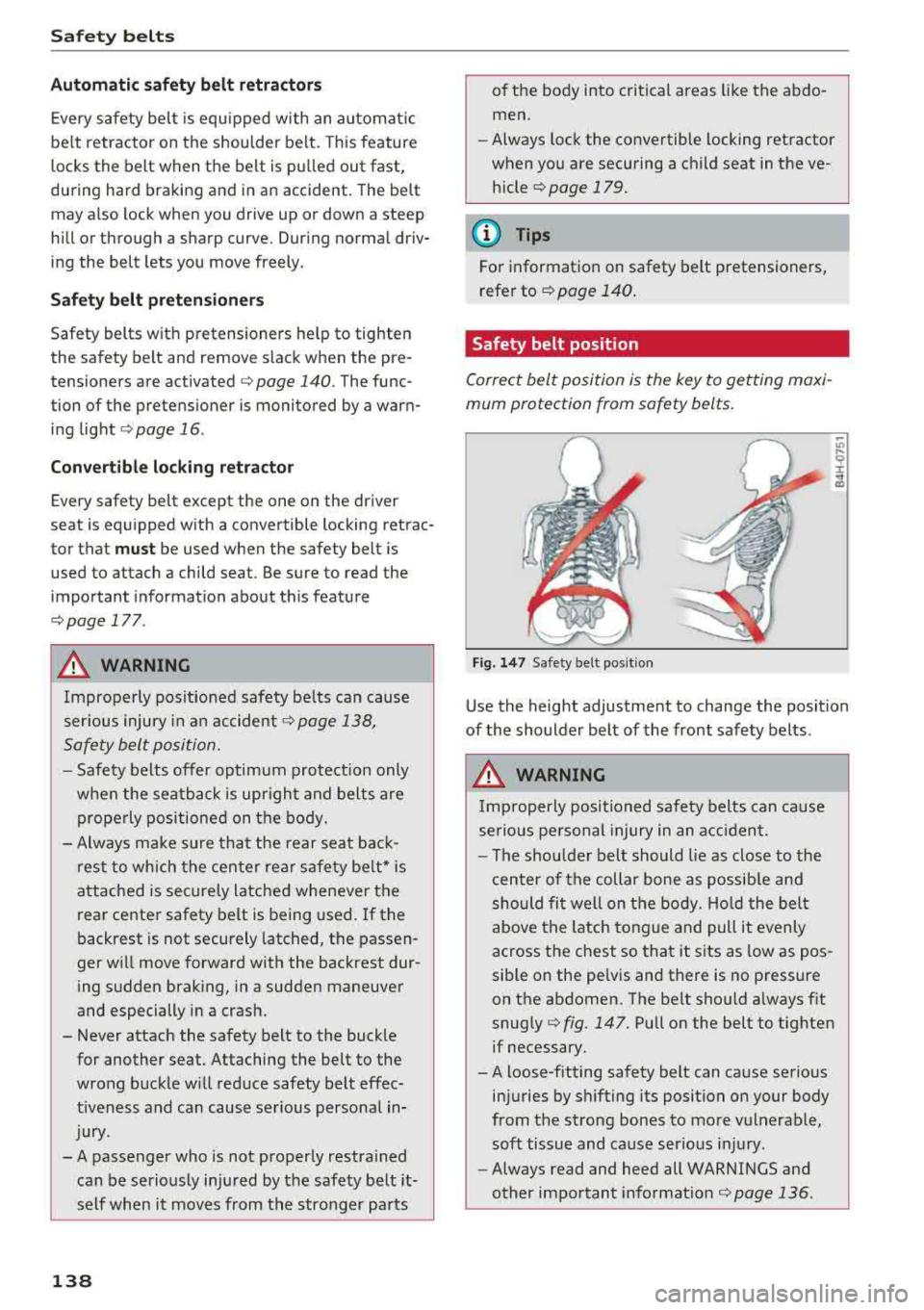
Safe ty belts
Autom ati c s afet y belt retractors
Every safety be lt is equ ipped with an automatic
be lt retractor on the shoulder belt. This feature
locks the belt when the belt is pu lled out fast,
during hard braking and in an accident. The belt may a lso lock when you drive up or down a steep
hill or through a sharp curve. Dur ing normal driv
ing the belt lets you move freely.
Safety belt p ret en sione rs
Safety belts w ith pretensioners he lp to tighten
the safety belt and remove s lack when the pre
tensioners are activated
c;, page 140 . The func
tion of the pretensioner is monitored by a warn
ing light
c;, page 16 .
Convertibl e loc king r etracto r
Every safety belt except the one on the driver
seat is equipped w ith a convertible locking retrac
tor that
must be used when the safety belt is
used to attach a child seat. Be sure to read the
important information about this feature
¢ page 177 .
.&_ WARNING
Improperly pos itioned safety be lts can cause
ser ious injury in an
accident ¢ page 138,
Safety belt position.
- Safety belts offer optimum protection only
when the seatback is upright and belts are
properly positioned on the body.
- Always make sure that the rear seat bac k
rest to which the center rea r safety be lt* is
attached is securely latched whenever the
rear center safety belt is being used. If the
backrest is not securely latched, the passen
ger will move forward with the backrest dur
ing sudden braking, in a sudden maneuver
and especially in a crash.
- Never attach the safety belt to the buckle for another seat. Attaching the belt to the
wrong b uckle wi ll reduce safety belt effec
t iveness and can cause serious person-a l in
jury.
- A passenger who is not proper ly restrained
can be seriously in jured by the safety be lt it
self when it
moves from the stronger parts
138
of the body into critical areas like the abdo men.
- Always lock the convertible locking retractor
when you are securing a child seat in the ve
hicle
,=;, page 179 .
(D Tips
For information on safety belt pretensioners,
refer to
c;, page 140 .
Safety belt position
Correct belt position is the key to getting maxi
mum protection from safety belts .
Fig. 147 Safety belt posit ion
Use the height adjustment to change the posit ion
of the shoulder belt of the front safety belts .
.&_ WARNING
Imp roperly positioned safety belts can cause
serio us pe rsonal injury in an a cc ident.
- The shou lde r belt should lie as close to the
center of the collar bone as possib le and
should fi t well on the body. Ho ld the belt
above the latch to ngue and pull it evenly
across the chest so that it sits as low as pos
sible on the pe lvis and there is no pressure
on the abdomen. The belt should a lways f it
snug ly
c;, fig. 147. Pull on the belt to tighten
if necessary.
- A loose-fitting safety belt can cause serious
injuries by sh ifting its position on your body
from the strong bones to more vulnerable,
soft tissue and cause serious i nju ry .
- Always read and heed all WARNINGS and
other important informat ion
c;, page 136 .
Page 142 of 266
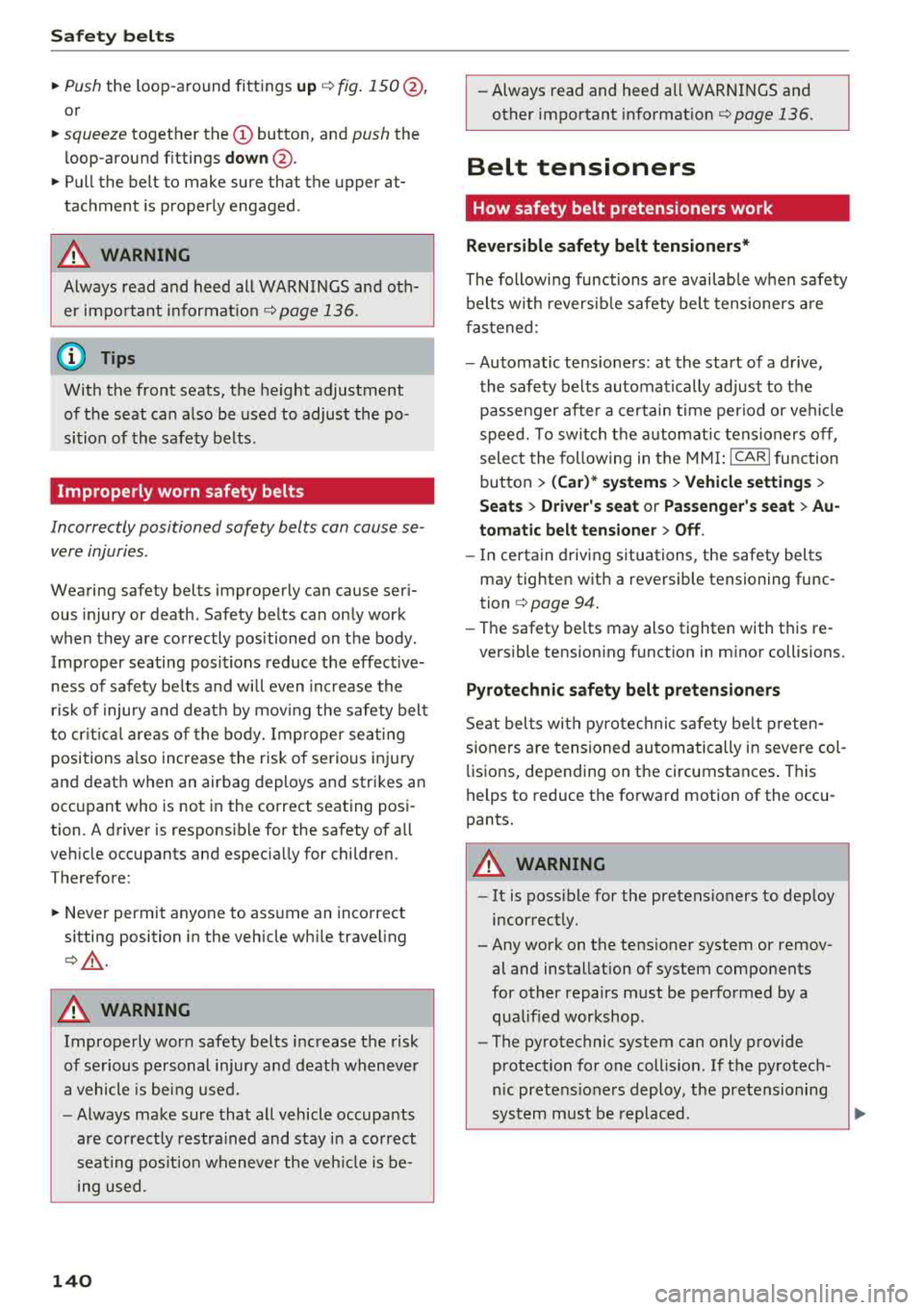
Safe ty belt s
~ Push the loop -around fittings up ¢ fig. 150 @,
or
~ squeeze together the (D button, and push the
loop-around fittings
do wn@ .
~ Pull the belt to make sure that the upper at
tachment is properly engaged .
A WARNING
Always read and heed all WARNINGS and oth
er impo rtant informat io n
¢page 136.
(D Tips
With the front seats, the height adjustment
of the seat can also be used to adjust the po
sition of the safety belts .
Improperly worn safety belts
Incorrectly positioned safety belts can cause se
vere injuries .
Wearing safety belts improperly can cause seri
ous injury or death. Safety belts can only work
when they are correctly pos itioned on the body .
Imp roper seating posit ions reduce the effect ive
ness of safety be lts and will even inc rease the
risk of injury a nd deat h by mov ing the safety bel t
t o cr it ica l areas of the body. Imp roper sea ting
positions a lso increase the risk of serio us inj ury
and death when an airbag deploys and strikes an
occupant who is not in the correct seating posi
tion. A driver is responsible for the safety of all
ve hicle occupants and especia lly for children.
Therefore:
~ Never permit anyone to ass ume an inco rrect
s itting position in the vehicle wh ile trave ling
¢A .
A WARNING
Improperly wor n safety be lts increase the risk
of se rious personal injury a nd death wheneve r
a vehicle is be ing used.
- Always make sure that a ll vehicle occupa nts
are co rrect ly restra ined and stay i n a co rrect
sea ting pos it ion wheneve r the veh icle is be
ing used.
140
- Always read and heed all WARNI NGS and
other impo rtant
informat ion¢ page 136.
Belt tensioners
How safety belt pretensioners work
Reversible safety belt tensioners*
The following functions a re availab le when safety
belts w ith reversib le safety belt tensioners a re
fastened:
- Automatic tens ioners: at the start of a drive,
the safety belts automat ica lly adjust to t he
passenger after a ce rtain time per iod or ve hicle
speed. To switch t he a utomat ic tens ioners off,
select the follow ing in t he M MI :
!CARI function
button
> ( Car )* sy stem s > Vehicle settings >
Seats > Driver 's seat or Passenger' s seat > Au
tomatic belt tensione r
> Off.
-In certain driving situations, the safety belts
may tighten wit h a reversib le tensioning func
tion
c> page 94.
- The safety be lts may also tighten with this re -
vers ible tension ing funct ion in m inor collisions.
Pyrotechnic safety belt pretensioners
Seat bel ts with py rotechnic safety be lt p reten
s ione rs are tensioned automati cally in severe col
li sions, depending on the circumstances . This
helps to reduce the forwa rd motion of the occu
pants.
A WARNING
- It is possible for the pretensioners to dep loy
incorrect ly.
- Any work on the tens ioner system or remov
al and installation of system components
for other repairs m ust be performed by a
qua lified workshop.
- The pyrotechnic system can only provide
protection for one collis ion. If t he py rotech
n ic pretens ione rs deploy, the pretensioning
system must be rep laced.
Page 144 of 266
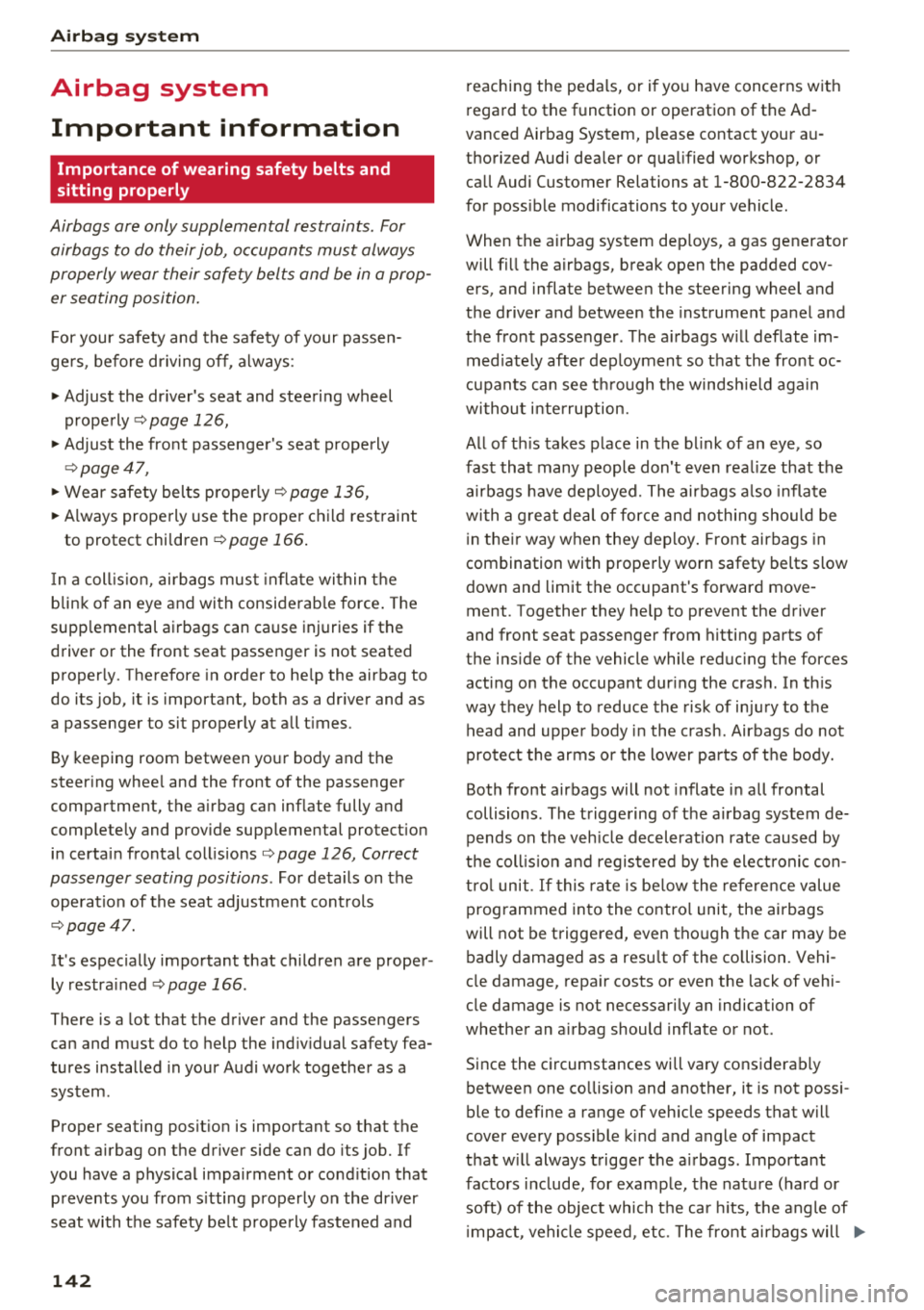
Airbag system
Airbag system
Important information
Importance of wearing safety belts and
sitting properly
Airbags are only supplemental restraints . For
airbags to do their job, occupants must always
properly wear their safety belts and be in a prop er seating position.
For your safety and the safety of your passen
gers, before driving off, always:
.,. Adjust the dr iver's seat and steering wheel
properly~ page 126,
.,. Adjust the front passenge r's seat properly
~page 47 ,
.,. Wear safety belts p roperly ~page 136,
.. Always properly use the proper child restraint
to protect chi ldren
~page 166 .
In a coll is ion, airbags must inflate within the
blink of an eye and with considerable force. The
supp lemental airbags can cause injuries if the
driver or the front seat passenger is not seated
properly. Therefore in order to he lp the airbag to
do its job, it is important, both as a dr iver and as
a passenger to sit properly at all t imes.
By keeping room between your body and the
steering whee l and the front of the passenger
compartment, the air bag can inflate fully and
completely and provide supplemental protect ion
in certain frontal
coll isions¢ page 126, Correct
passenger seating positions .
For details on the
operation of the seat adjustment controls
¢ page 47.
It's especially important that children are proper
ly restrained
¢pag e 166.
There is a lot that the driver and the passengers
can and must do to help the ind iv idual safety fea
tures installed in your Audi work together as a
system.
Proper seating posit ion is important so that the
front airbag on the driver side can do its job. If
you have a physical impairment or cond ition that
prevents you from s itting properly on the driver
seat with the safety be lt properly fastened and
142
reaching the pedals, or if you have concerns with
regard to the function or operation of the Ad
vanced Airbag System, please contact your au
thorized Audi dea ler or qualified workshop, or
ca ll Audi Customer Relations at 1-800-822-2834
for poss ible modifications to your vehicle .
When the airbag system dep loys, a gas generator
will fill the airbags, break open the padded cov ers, and infla te between the steering wheel and
the driver and between the instrument panel and
the front passenger. The a irbags w ill deflate im
med iate ly after deployment so that the front oc
cupants can see through the windsh ield aga in
without interruption.
All of th is takes place in the blink of an eye, so
fast that many people don't even realize that the
a irbags have deployed. The airbags also inflate
with a great deal of force and nothing should be
in the ir way when they deploy. Front airbags in
combination with properly worn safety belts slow
down and limit the occupant's forward move
ment. Together they help to prevent the driver
and front seat passenger from hitting parts of
the ins ide of the vehicle while reduc ing the forces
acting on the occupant dur ing the crash . In th is
way they help to reduce the risk of injury to the
head and upper body in the crash . Airbags do not
protect the arms or the lower parts of the body.
Both front airbags will not inflate in all frontal
collisions. The triggering of t he a irbag system de
pends on the veh icle deceleration rate caused by
the collis ion and registered by the electronic con
trol unit. If this rate is be low the refe rence value
programmed into the control unit, the airbags
will not be triggered, even tho ugh t he car may be
badly damaged as a resu lt of the co llision . V ehi
cle damage, repair costs or even the lack of vehi
cle damage is not necessarily an indication of
whether an a irbag should inflate or not.
Since the circumstances wi ll vary considerab ly
between one co llision and another, it is not possi
ble to define a range of veh icle speeds that will
cover every poss ible kind and angle of impact
that w ill always trigger the airbags. Important
factors include, for example, the nature (hard or
soft) of the object which the ca r hits, the angle of
im pact, vehicle speed, etc. The front airbags will
..,.
Page 237 of 266
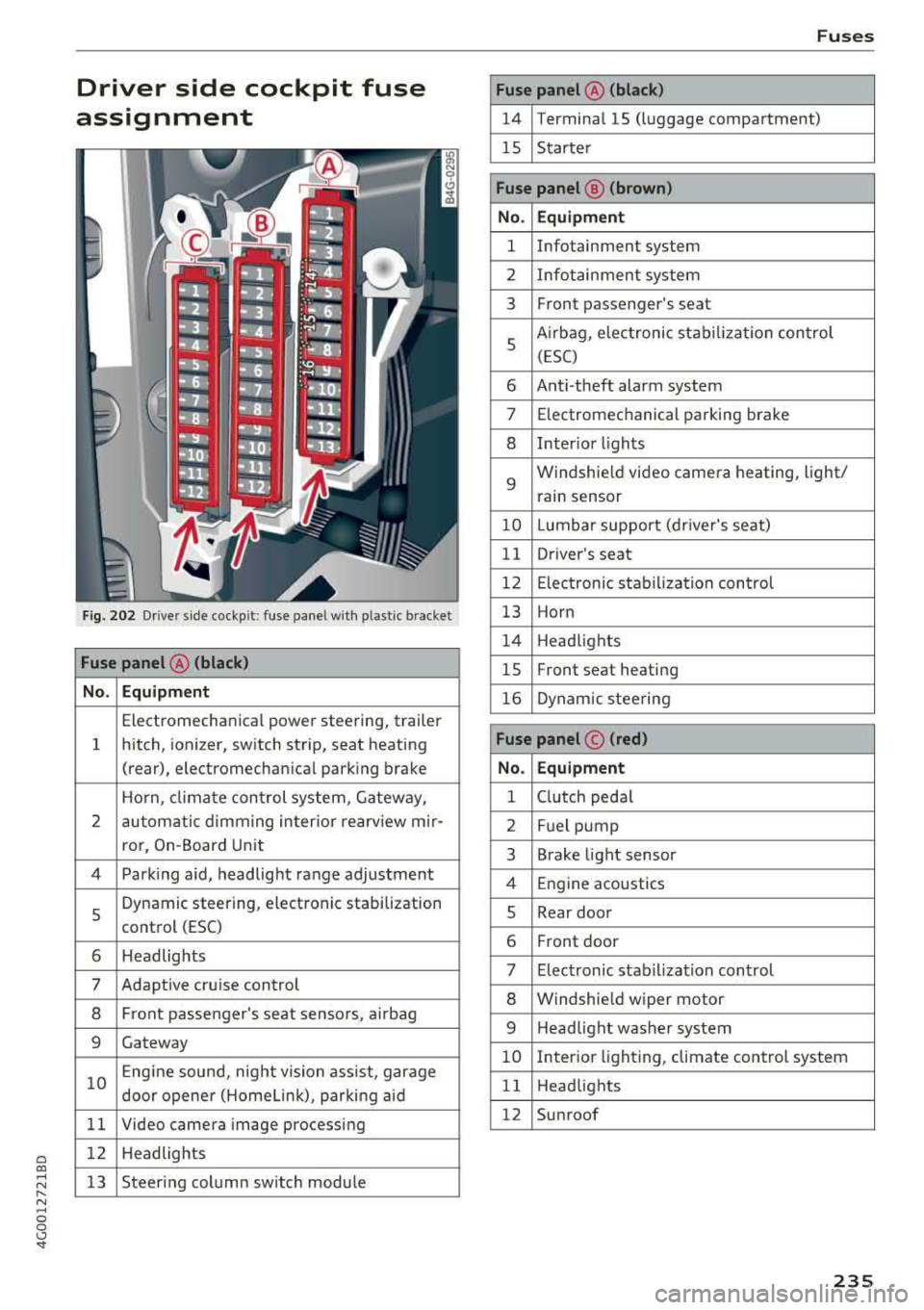
a co ,...,
N
" N ,...,
0 0 \,;J '
assignment
F ig. 202 Drive r side cockp it : fuse panel w it h plastic bracket
Fuse panel @ ( black)
No . Equipment
Electromechan ica l powe r stee ring, trailer
1 hitch, ionizer, switch st
rip, seat heating
(rear), electromechan ica l park ing brake
Ho rn, climate con trol system, Gateway,
2 au
tomati c dimm ing in ter ior rearv iew m ir-
ro r, On -Board Unit
4 Park ing aid, headlight range adjustment
5
Dynamic steering, electronic stabilization
control (ESC)
6 Headlights
7 Adapt ive cru ise control
8 Front passenger's seat senso rs, a irbag
9 Gateway
10 Engine sound, nig
ht vision ass ist, garage
door opene r (H ome link), parki ng aid
11 Video camera
image processi ng
12 Headlights
13 Steering column sw
itch module
Fuses
Fuse panel @ (black)
14 Termina l 15 (luggage compartment)
1 5 Starte r
Fuse panel @ (brown)
No . Equipment
1 Infotainment system
2 Infot ainment system
3 Front passenger's seat
5
A
ir bag, e lec tronic sta bi liz ation con trol
( E SC)
6 Ant
i- theft alarm system
7 E lectromec ha nical pa rking brake
8 Inter io r li ghts
9
Windshie ld video came ra heating, light/
r ain sensor
10 Lumbar support (dr iver's se at)
11 Driver
's seat
12 Electronic stab ilizati on con trol
13 Horn
1 4 Head lights
lS Front seat heating
16 Dynamic s tee ring
Fuse panel © (red)
No . Equipment
1 Clutch peda l
2 Fuel p ump
3 Brake
light sensor
4 Engine acoustics
5 Rear door
6 Fr
ont door
7 Elec tronic stab iliza tion control
8 Windshie ld wiper motor
9 H ead light washer system
10 Interio
r light ing, climate control system
1 1 Head lights
12 Sunroof
235